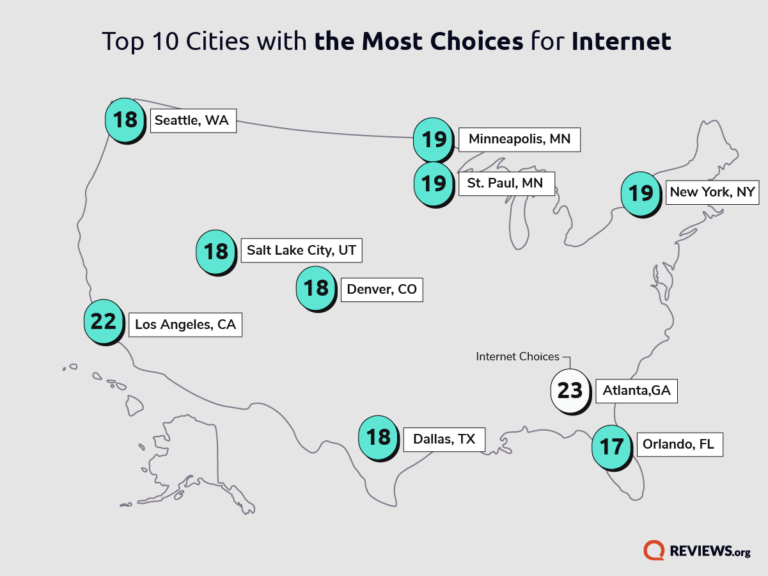We looked at average download speeds for cities across the US in 2021 to identify those leading the pack and those bringing up the rear.
The 10 Fastest and Slowest Cities for Internet Speed
Our latest look at internet speeds in 2021 shows that average download speeds are continuing to rise across the US: 2021 saw speeds hit an average of 119 Mbps, up from 57 Mbps in 2020.
After comparing cities with at least 100 speed tests taken in 2021, we saw many metros improve the average download speeds their citizens can get. But others still lagged behind the rest of the country. This is a huge deal, especially since many of us moved to more rural areas once working from home became an option.
If you haven’t moved yet but are thinking of relocating to a quieter home, here are the top cities to consider—plus a handful you might want to avoid if you rely on the internet to get work done.

10 cities with the fastest internet speeds
We’re excited to see cities from all over the US rank in the top 10 for the fastest average download speeds. In the past, zippy download speeds seemed to be limited to the coasts. (Which does seem to be the case for fastest internet speed by US state)
But now, cities like Goodyear, Arizona, a suburb of Phoenix (well, what Arizona city isn’t?) and Alliance, Ohio, located near Akron, lead the pack.
The best news is, each of these cities averaged download speeds of more than 200 Mbps. We typically recommend folks start with 100 Mbps download speeds and aim for faster speeds depending on how many people live in their home. Speeds of 200 Mbps are ideal for a small to mid-sized family who likes to stream, game, and work from home.
*Average download speeds calculated using proprietary speed test data for January 1–December 31, 2021.
**City population data retrieved from 2020 US Census reports.
10 cities with the slowest internet speeds in 2021
We’re not surprised to see most of the cities with the slowest average download speeds in 2021 have small populations. It’s no secret that building out internet infrastructure to get to folks in hard-to-reach places is expensive.
Thankfully, new technology, like fixed wireless and low-earth-orbit satellites, is building out to bring internet into rural areas where your typical cable, fiber, and DSL providers haven’t gone.
The unfortunate part is that these average download speeds are far too slow to access modern-day websites, let alone stream video, hop on Zoom calls, or take part in online learning. We hope to see these towns get more internet options with faster speeds in the near future.
*Average download speeds calculated using proprietary speed test data for January 1–December 31, 2021.
**City population data retrieved from 2020 US Census reports unless otherwise noted.
†Ibapah, UT population retrieved from Utah Division of Indian Affairs: Confederated Tribes of the Goshutes.
10 cities with the biggest difference in fastest and slowest speeds in 2021
Big cities usually mean big download speed numbers. Internet providers tend to focus on large metro areas because there are so many potential customers—and it’s likely they’ve already got infrastructure built out in the area.
But not every part of a big city is home to speedy internet. While some of this may be due to customers choosing internet plans with slower speeds, it’s also partly due to faster speeds being offered in the most densely populated locations. So folks in the suburbs or poorer, less populated parts of town may not have an option of 500 Mbps download speeds.
Here’s some of the US’s largest metros look when you compare the slowest recorded download speed to the fastest recorded download speed.

*Average download speeds calculated using proprietary speed test data for January 1–December 31, 2021.
10 cities with the most internet providers to choose from in 2021
Having a choice between two or more internet providers could mean the difference between ridiculous prices and slow speeds versus fair prices and fast speeds.
Many folks in the US have only one provider to choose from. This leaves them high and dry if that provider decides to charge more, offer lackluster support, or worse, eliminate network infrastructure.
That’s why we’ve taken a look at which cities have the most internet providers to choose from. Granted, larger cities may still see residents with fewer choices in certain areas, so take these numbers with a grain of salt.

*Number of providers calculated using proprietary speed test data for January 1–December 31, 2021.
Methodology
To determine the US’s fastest and slowest cities in terms of internet speed, we dug into speed test results from January 1, 2021 through December 31, 2021. We then narrowed down our list to cities with a minimum of 100 speed test results, then filtered out any results for business internet, cellular data, and incomplete or duplicate entries.
Next, we averaged download speeds for each city to determine the fastest and slowest cities in 2021. We also compared results for January and December to determine which cities saw the most improvement in internet speed over the year. We used 2020 US Census data to determine city population where available, unless otherwise noted.
Lastly, we tallied the number of internet providers represented in each city to see which ones offer the most ISP choices.
50 cities with the fastest and slowest internet speeds
Dig in a little deeper to see the top 25 fastest cities and bottom 25 slowest cities for internet speed.
*Average download speeds calculated using proprietary speed test data for January 1–December 31, 2021.
Related Articles



